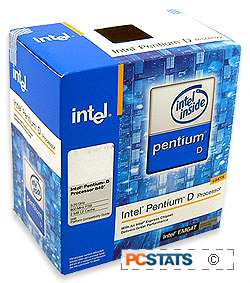The Pentium D 840 represents the state of the art in
Intel processors, not just because of its dual core nature, but because of the
other features it incorporates as well. The most significant extra that this CPU
brings to the table is its support for 64-bit x86-64-based operating systems
through Intel's EMT64 technology. Like AMD's Opteron and Athlon 64, the Pentium
D processor can run both 32-bit and 64-bit operating systems and applications
(almost) interchangeably. For more details on how this works, see PCSTATS article on the subject.
 The second new(ish) feature is support for the NX Bit, a form
of system security which attempts to end the possibility of buffer overflow
attacks - where malicious software overloads an area of memory then uses the
resulting memory hole to execute alien programs - by restricting which areas of
memory can execute application code. The NX Bit feature must be supported by
both the operating system and the processor.
The second new(ish) feature is support for the NX Bit, a form
of system security which attempts to end the possibility of buffer overflow
attacks - where malicious software overloads an area of memory then uses the
resulting memory hole to execute alien programs - by restricting which areas of
memory can execute application code. The NX Bit feature must be supported by
both the operating system and the processor.
Windows XP Service Pack 2 includes support for it, and we saw this technology
in action first hand when it interrupted our running of the Business Winstone
2004 test.
Apparently the benchmark attempts to run active X controls within an Internet
Explorer Window as part of the test, and the system flagged and halted this
process. We've never had any problem with this technology using Athlon 64
processors which also support it, but it's good to know the feature is working,
I guess.
The Intel
Pentium D 830 and Intel Pentium D 840 processors also incorporate
Intel's EIST (Enhanced Intel SpeedStep Technology), as seen in the 6xx line
of Pentium 4 processors. EIST can sense when the cores are being under utilized
and dynamically reduce the CPU multiplier to slow down the processor, reducing both
energy consumption and heat.
EIST works hand in hand with Intel's TM2 (Thermal Monitor 2) and C1E advanced
halt state technologies which monitor and reduce the processor's speed in
overheating and idle conditions respectively. A speed of 2.8GHz (14 x 200) is
the lowest state to which EIST will reduce the Pentium D's speed though, which
explains why the Intel Pentium D 820 processor ( which runs at 2.8GHz already)
does not feature this technology, nor TM2 and C1E support.
 Models and (affordable -gasp) Pricing
Models and (affordable -gasp) Pricing
The
Pentium D is available in three different models as of July, 2005:
Pentium D
840 @ 3.2GHz $555USD (CAD$760)
Pentium D 830 @ 3.0GHz $330USD (CAD$400)
Pentium D 820 @ 2.8GHz $250USD (CAD$305)
All models share the same 2 x 1MB L2 cache configuration, 800MHz
FSB and features, except the Intel Pentium D 820 lacks Intel's
EIST technology built in. This is because EIST currently only drops
processor speed to a minimum of 2.8GHz, which is the default speed of the
Pentium D 820 to begin with.
As you can see, Intel has priced its dual-core offerings significantly lower
than AMD's equivalent; the top-of-the-line Athlon64 X2 4800+ starts
at over $900USD! This seems like a sensible strategy to us, allowing
Intel to more effectively target business users that need multi-processing.
Excepting the computer
enthusiast market that jumps on anything new and pricey, business
users will likely find the most to like about the new dual-core Intel
and AMD processors, since the software that will derive the most benefit from them
is all business and content-creation oriented.
